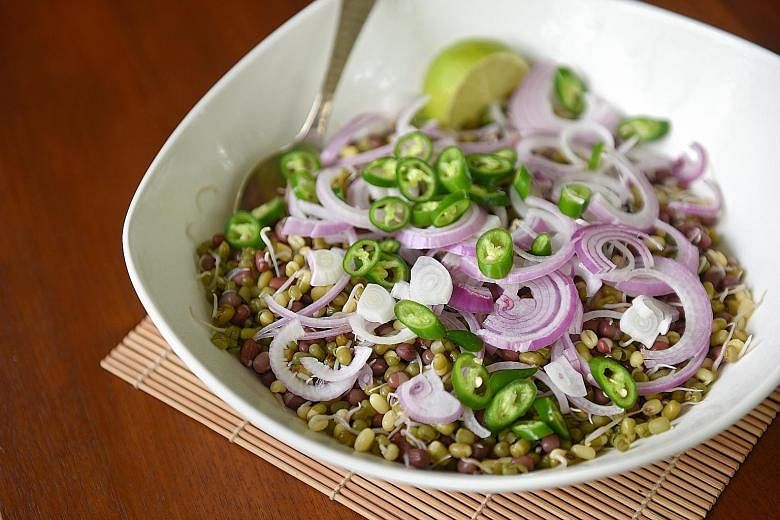Remember the days back in school when we tried to sprout mung beans in wet cotton wool?
Well, those days are back for me, for I have been sprouting mung and adzuki beans, or what we know as green and red beans, in my kitchen.
I feel like a schoolgirl again, except that the exercise is no longer just for fun, but for dinner.
Thanks to a friend, I have discovered salads made with sprouted beans and they are delicious.
-
INGREDIENTS
-
I cup adzuki beans
1 cup mung beans
1 small square dried kombu
1 red onion, peeled and sliced
2 green chillies, sliced
½ tsp salt
black pepper to taste
Juice from half a green lime
METHOD
1. Wash and pick dried beans, discard the less-than-perfect ones.
2. Soak them overnight in a container large enough to allow for expansion. They will nearly double in size.
3. Discard the water and wash the beans well. Drain beans and put in a wire colander with a plate below. Leave in a dark place to germinate.
4. Rinse the beans once or twice every day. When the shoots start showing, they are ready.
5. Bring a pot of salted water to a boil, add a strip of dried kombu and the sprouted beans.
6. Drain and cool the beans under a running tap. Place the sprouted beans in a salad bowl.
7. Top with sliced onions and green chillies. Season with salt and pepper. Add a squeeze of lime juice. Toss before eating and serve with curries or a soup.
SERVES FOUR TO FIVE
Sprouted beans are more digestible than dried beans, and are rich in fibre and nutrients. They are also easier to cook, taking only minutes for the dish to be ready.
They make a versatile salad, with onions added for crunch and sweetness and green chillies for bite. You can also add vegetables such as fennel bulbs and cucumber.
The salad goes well with Indian food such as curries, but it can go with most meals and on its own.
And it is easy to sprout beans. You can also sprout seeds and legumes such as lentils and peas, though you can buy ready-sprouted mixed beans at some supermarkets.
You merely soak the beans overnight, wash them well and leave them in a colander, rinsing them a few times a day.
They will sprout within a day, especially if the weather is hot and humid. When you see a tiny shoot, it is ready to be cooked.
After sprouting, blanch the beans quickly in boiling water, then stop the cooking by plunging them in cold water and they are done.
Do add a strip of kombu to the pot. Kombu, a dried seaweed, helps to soften the beans while cooking. It also helps digestion and is a great source of trace minerals.
I like the sprouted beans lightly boiled and seasoned with salt and pepper and a squeeze of lime. But you can add all sorts of seasonings, such as garam masala, for a hint of Indian spicing.
For this version, I added raw onions and green chillies. You can also add spring onions, fresh coriander or other green herbs for a more subtle lift.
These are grown-up tastes despite the childish beginnings in sprouting activity and I think they would stand me in good stead into my later years.
High-risk groups should avoid raw sprouts
This is a high-protein, high- fibre dish that is low in fat.
It is also high in folate, magnesium and potassium.
Adzuki and mung beans belong to the legume family and have a very similar nutrient content.
They are a great source of protein (especially for vege- tarians), B vitamins, iron, folate, potassium, magnesium and dietary fibre.
The beans are high in fibre, which helps in lowering the glycemic index of your meal. This is great for diabetics.
The beans are also high in soluble fibre, which binds to the excess cholesterol in your body and gets rid of it. This also helps to lower the risk of a cardiovascular attack.
-
NUTRITIONAL INFORMATION (per serving)
-
Energy: 286kcal
Protein: 18.4g
Total fat: 0.8g
Saturated fat: 0.3g
Cholesterol: 0mg
Carbohydrate: 52.4g
Dietary fibre: 13.3g
Sodium: 501mg
The beans contain many antioxidants, such as polyphenols and flavonoids, which can help lower the risk of some cancers.
Some sprouts have a high content of sulforaphane, a phytochemical that can help to fight cancer.
Others contain phytoestrogen, a phenolic compound that has been shown to have beneficial effects on the heart.
However, sprouted beans do carry a risk of food poisoning, if eaten raw. They may carry the bacteria, Salmonella and Escherichia coli.
Therefore, people such as the elderly, children, pregnant women and people with weakened immune systems should avoid eating raw sprouts.
Jaclyn Reutens
Dietitian, Aptima Nutrition & Sports Consultants

